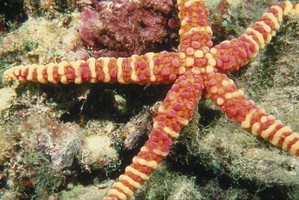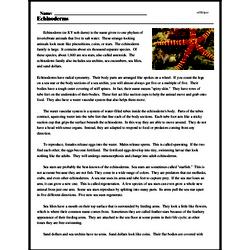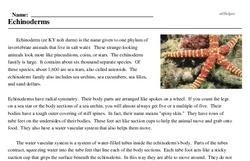Echinoderms
Echinoderm (ee KY noh durm) is the name given to one phylum of invertebrate animals that live in salt water. These strange-looking animals look more like pincushions, coins, or stars. The echinoderm family is large. It contains about six thousand separate species. Of these species, about 1,600 are sea stars, also called asteroids. The echinoderm family also includes sea urchins, sea cucumbers, sea lilies, and sand dollars.
Echinoderms have radial symmetry. Their body parts are arranged like spokes on a wheel. If you count the legs on a sea star or the body sections of a sea urchin, you will almost always get five or a multiple of five. Their bodies have a tough outer covering of stiff spines. In fact, their name means "spiny skin." They have rows of tube feet on the undersides of their bodies. These feet act like suction cups to help the animal move and grab onto food. They also have a water vascular system that also helps them move.
The water vascular system is a system of water-filled tubes inside the echinoderm's body. Parts of the tubes contract, squeezing water into the tube feet that line each of the body sections. Each tube foot acts like a sticky suction cup that grips the surface beneath the echinoderm. In this way they are able to move around. They do not have a head with sense organs. Instead, they are adapted to respond to food or predators coming from any direction.




